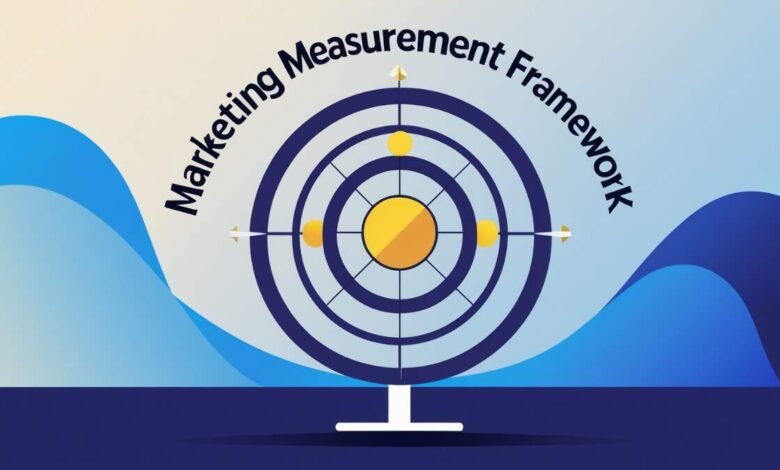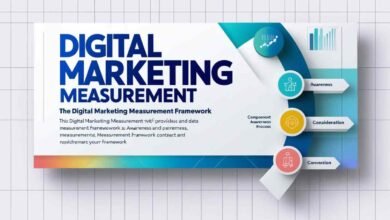Marketing Measurement Framework: How to Build an Effective
Marketing Measurement Framework

Marketing measurement framework is essential for businesses striving to achieve sustainable growth. This comprehensive guide will help you understand the core components of an effective framework while integrating metrics like Key Performance Indicators (KPIs), Return on Investment (ROI), Customer Lifetime Value (CLV), and Attribution Modeling. By adopting a data-driven marketing approach, businesses can make smarter decisions, improve campaign performance, and maximize profits.
What is a Marketing Measurement Framework?
It involves defining goals, selecting appropriate metrics, and analyzing the outcomes to drive informed decisions. This framework is a roadmap for businesses to track success and optimize strategies.
Why is a Marketing Measurement Framework Important?
Aligning Goals and Objectives
A robust framework ensures marketing efforts align with broader business objectives, creating a unified strategy across departments.
Enhancing Accountability
By identifying specific KPIs, marketers can measure the effectiveness of campaigns and justify their budgets.
Data-Driven Decision Making
Incorporating a framework encourages reliance on data rather than intuition, leading to more precise targeting and higher returns.
Core Elements of a Marketing Measurement Framework
Defining Objectives
Start by identifying your primary business goals, whether it’s increasing brand awareness, generating leads, or boosting revenue
Selecting Key Performance Indicators (KPIs)
KPIs are the metrics that reflect progress toward your objectives. Choose KPIs relevant to your goals, such as:
- Website traffic and engagement
- Conversion rates
- Customer retention rates
- Revenue growth
Tracking Return on Investment (ROI)
ROI is critical for understanding the financial success of your campaigns. To calculate ROI, use the formula:
This metric helps businesses prioritize campaigns that deliver maximum value.
Measuring Customer Lifetime Value (CLV)
It informs strategies for customer acquisition and retention, enabling marketers to focus on high-value segments.
Leveraging Attribution Modeling
Attribution modeling assigns credit to various marketing touchpoints, helping businesses understand which channels contribute most to conversions. Common models include:
- First-Touch Attribution: Credits the first interaction.
- Last-Touch Attribution: Credits the final interaction.
- Multi-Touch Attribution: Distributes credit across all interactions.
Building a Data-Driven Marketing Strategy
Data-driven marketing uses insights from customer behavior, preferences, and interactions to craft tailored strategies. Here’s how to incorporate it into your framework:
Collect and Analyze Data
Use tools like Google Analytics, CRM systems, and marketing platforms to gather data on customer interactions. Analyze patterns to identify trends and opportunities.
Test and Optimize Campaigns
Employ A/B testing to compare campaign elements, such as headlines or visuals. Optimize campaigns based on performance data to achieve better results.
Challenges in Marketing Measurement
Data Silos
- Fragmented data across departments can hinder analysis. Integrating systems ensures a holistic view of performance.
Attribution Complexity
- With multiple touchpoints in a customer’s journey, assigning credit accurately can be challenging. Invest in advanced attribution tools for better insights.
Changing Metrics
- Marketing metrics evolve with trends. Stay updated to ensure your framework remains relevant.
Best Practices for Effective Measurement
- Set Clear Benchmarks: Establish baseline metrics to measure progress effectively.
- Automate Reporting: Use dashboards to simplify tracking and reporting.
- Communicate Insights: Share findings across teams to align efforts.
- Iterate Continuously: Regularly update your framework based on performance data.
Incorporating Predictive Analytics
This can help marketers anticipate trends, identify high-value prospects, and allocate budgets more effectively. Proactively address customer needs.
- Optimize marketing spend by targeting audiences likely to convert.
- Improve campaign timing based on predictive models.
Tools for Predictive Analytics:
- Google Analytics 4: Advanced tracking features that offer predictive insights.
- HubSpot: Includes forecasting tools to predict lead behavior.
- Tableau: A powerful platform for visualizing and analyzing complex data.
Emphasizing Cross-Channel Measurement
In today’s multi-channel environment, customers interact with brands across multiple touchpoints, including social media, email, websites, and in-store visits. Measuring performance across these channels ensures a comprehensive understanding of your marketing efforts.
Key Metrics for Cross-Channel Analysis:
- Engagement Rates: Track user interaction on social media and websites.
- Channel-Specific ROI: Measure the return on each platform’s investment.
- Cross-Channel Attribution: Assign credit for conversions across all channels.
How to Implement Cross-Channel Measurement:
- Use tools like Adobe Analytics or Klaviyo to integrate data from multiple platforms.
- Adopt a Unified Marketing Dashboard to visualize all data in one place.
- Regularly evaluate which channels contribute most to conversions and adjust strategies accordingly.
Strengthening Customer Lifetime Value (CLV) Strategies
Customer Lifetime Value (CLV) is a critical component of any marketing measurement framework. It provides a lens into the long-term financial impact of acquiring and retaining customers. Here’s how you can enhance your CLV strategies:
1. Personalization
- Use customer data to offer personalized product recommendations.
- Implement loyalty programs to reward repeat customers.
2. Upselling and Cross-Selling
- Promote higher-value products or complementary services.
- Analyze past purchasing behavior to identify opportunities.
3.Customer Retention
- Offer excellent post-purchase support to improve retention rates.
- Collect feedback to address pain points and foster loyalty.
Advanced Attribution Modeling Techniques
Attribution modeling continues to evolve, offering increasingly nuanced ways to track campaign performance. Beyond the basics, consider these advanced techniques:
1.Data-Driven Attribution (DDA)
This approach uses machine learning to analyze how different touchpoints impact conversions. It assigns weight dynamically, providing a more accurate picture of performance.
2. Custom Attribution Models
Develop models tailored to your business. For example, if email marketing drives high-value customers, give it more weight in your attribution model.
3. Multi-Touch Attribution with AI
AI-powered tools like Google Attribution 360 can help marketers automate multi-touch modeling and uncover deeper insights.
The Role of Technology in Marketing Measurement
Modern tools and platforms streamline data collection, analysis, and reporting. Technologies such as AI and machine learning enhance predictive analytics, offering deeper insights into customer behavior. By adopting the right tools, businesses can build a scalable, efficient framework.
Conclusion
Creating a marketing measurement framework is a pivotal step for businesses aiming to thrive in a competitive environment. By focusing on Key Performance Indicators (KPIs), calculating Return on Investment (ROI), understanding Customer Lifetime Value (CLV), and leveraging Attribution Modeling, marketers can maximize their efforts. A data-driven marketing approach ensures precise decision-making, ultimately driving success.
FAQs
1. What is the purpose of a marketing measurement framework?
It helps businesses track, evaluate, and optimize marketing performance, aligning efforts with business goals.
2. How do KPIs impact a marketing strategy?
KPIs provide measurable benchmarks, enabling marketers to assess the success of their campaigns and make data-driven improvements.
3. Why is ROI important in marketing?
ROI measures the profitability of marketing efforts, helping businesses allocate resources effectively and maximize returns.
4. What is the role of attribution modeling?
Attribution modeling identifies which marketing channels and touchpoints contribute most to conversions, guiding budget allocation.
5.How does CLV influence marketing decisions?
CLV highlights the long-term value of customers, allowing businesses to focus on retention strategies and prioritize high-value segments.
Read More: B2B E-commerce Platform





